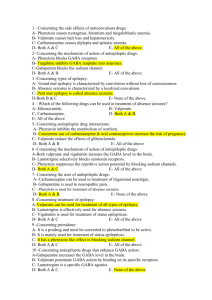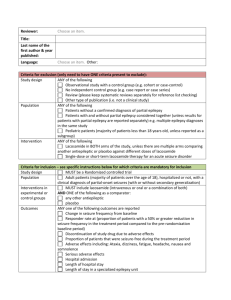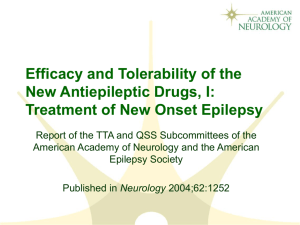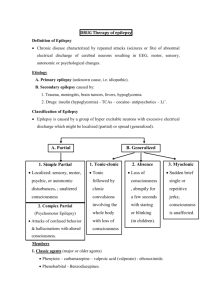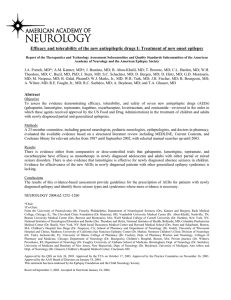Newly Diagnosed Epilepsy
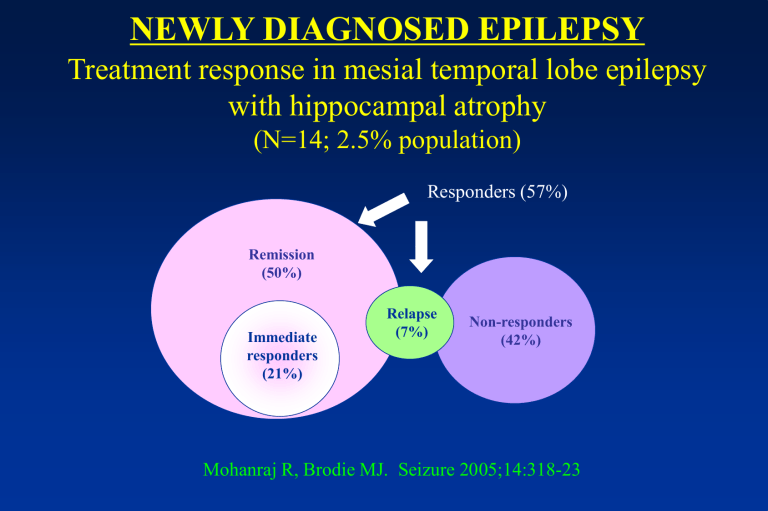
NEWLY DIAGNOSED EPILEPSY
Treatment response in mesial temporal lobe epilepsy with hippocampal atrophy
(N=14; 2.5% population)
Responders (57%)
Remission
(50%)
Immediate responders
(21%)
Relapse
(7%)
Non-responders
(42%)
Mohanraj R, Brodie MJ. Seizure 2005;14:318-23
NEWLY DIAGNOSED EPILEPSY
Antiepileptic drugs
20
15
10
Lacosamide
Rufinamide
Stiripentol
Pregabalin
Levetiracetam
Oxcarbazepine
Tiagabine
Topiramate
Fosphenytoin
Gabapentin
Felbamate
Lamotrigine
Zonisamide
Sodium Valproate
Ethosuximide
Vigabatrin
Carbamazepine
Benzodiazepines
Phenobarbital
Phenytoin
Primidone
5
Bromide
0
1840 1860 1880 1900 1920
Calendar year
1940 1960 1980 2000
NEWLY DIAGNOSED EPILEPSY
There is no reliable evidence to suggest any difference in efficacy between carbamazepine and phenytoin carbamazepine and valproate phenytoin and valproate phenobarbital and carbamazepine phenobarbital and phenytoin for partial or generalized tonic-clonic seizures
THE COCHRANE LIBRARY
NEWLY DIAGNOSED EPILEPSY
Randomized, head-to-head, double-blind trials with modern antiepileptic drugs
(N = 18)
Lamotrigine versus Carbamazepine (3), Gabapentin (2), Phenytoin
Oxcarbazepine versus Phenytoin (2), Carbamazepine, Valproate
Vigabatrin versus Carbamazepine
Gabapentin versus * Carbamazepine (2), Lamotrigine
Topiramate versus * Carbamazepine, * Valproate
Levetiracetam versus Controlled-release carbamazepine
* fixed doses
NEWLY DIAGNOSED EPILEPSY
Drug choice
As there are no major differences in efficacy among first-line antiepileptic drugs, tolerability and longterm safety must be the paramount consideration in patients with often mild newly diagnosed epilepsy
Kwan P, Brodie MJ. Neurology 2003; 60 (suppl 4): S2-S12
Efficacy
EFFECTIVENESS
The sum of two parts
Tolerability
NEWLY DIAGNOSED EPILEPSY
Observations from the Glasgow database
1098 adolescent and adult patients starting on their first antiepileptic drug between 1982 and 2005 and follow-up for at least 2 years
NEWLY DIAGNOSED EPILEPSY
Response rates (%) in an expanding cohort
Recruitment n One AED Combination Total
1982-1997 1 470
1982-2001 2 780
1982-2005 3 1098
61
59
61.9
3.0 64.0
5.4 64.4
6.4 68.3
1 Kwan P, Brodie MJ. N Engl J Med 2000; 342: 314-9
2 Mohanraj R, Brodie MJ. Eur J Neurol 2006; 13: 277-82
3 Bamagous G, Kwan P, Brodie MJ, in preparation
NEWLY DIAGNOSED EPILEPSY
Successful combinations*
2 AEDs 67
3 AEDs 2
4 AEDs
Total
1
70
* Seizure free for at least the previous year
FONDE STUDY
F ollowing O utcomes in N ewly D iagnosed E pilepsy
A prospective observational study of the pharmacological and lifestyle consequences of newly diagnosed epilepsy
FONDE STUDY
Objectives
To monitor pharmacological and social outcomes
over a prolonged period under conditions of care that mirror everyday clinical practice
in relation to a variety of clinical, investigational and environmental prognostic factors
across a range of clinical settings from general neurology to specialist epilepsy services
FONDE STUDY
All information at study visits will be entered into an electronic case record form and submitted to the
Central Data Management Centre in Milan
Separate data entry for children and adults
John Norrie statistician
